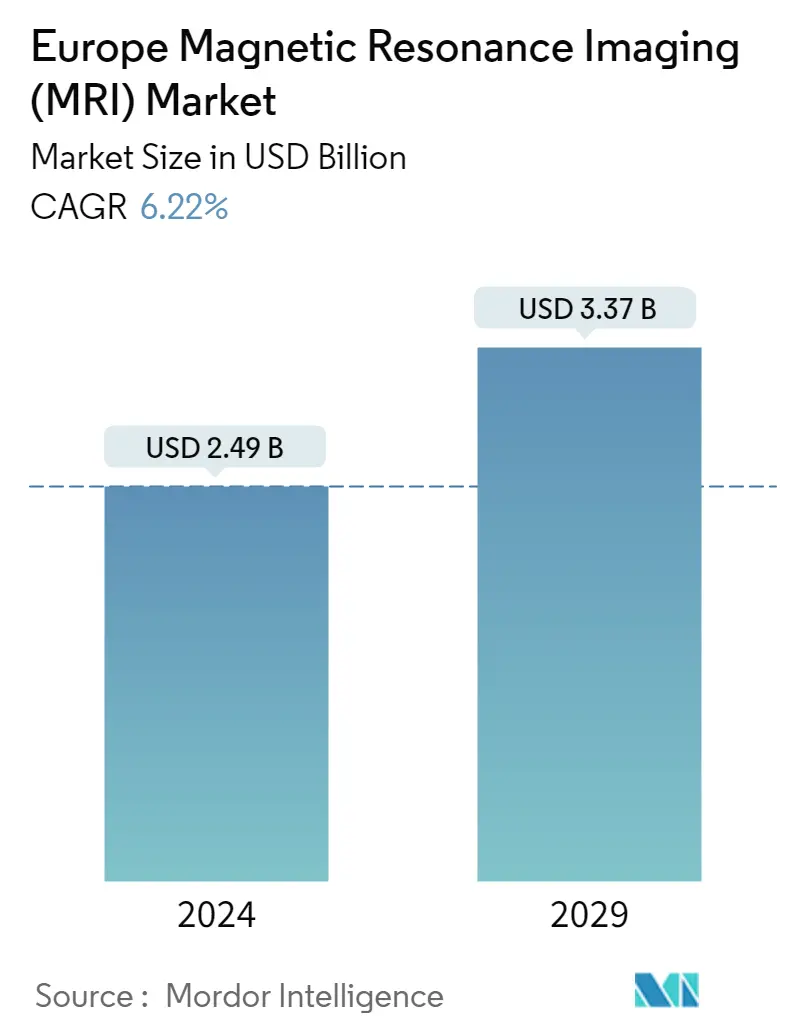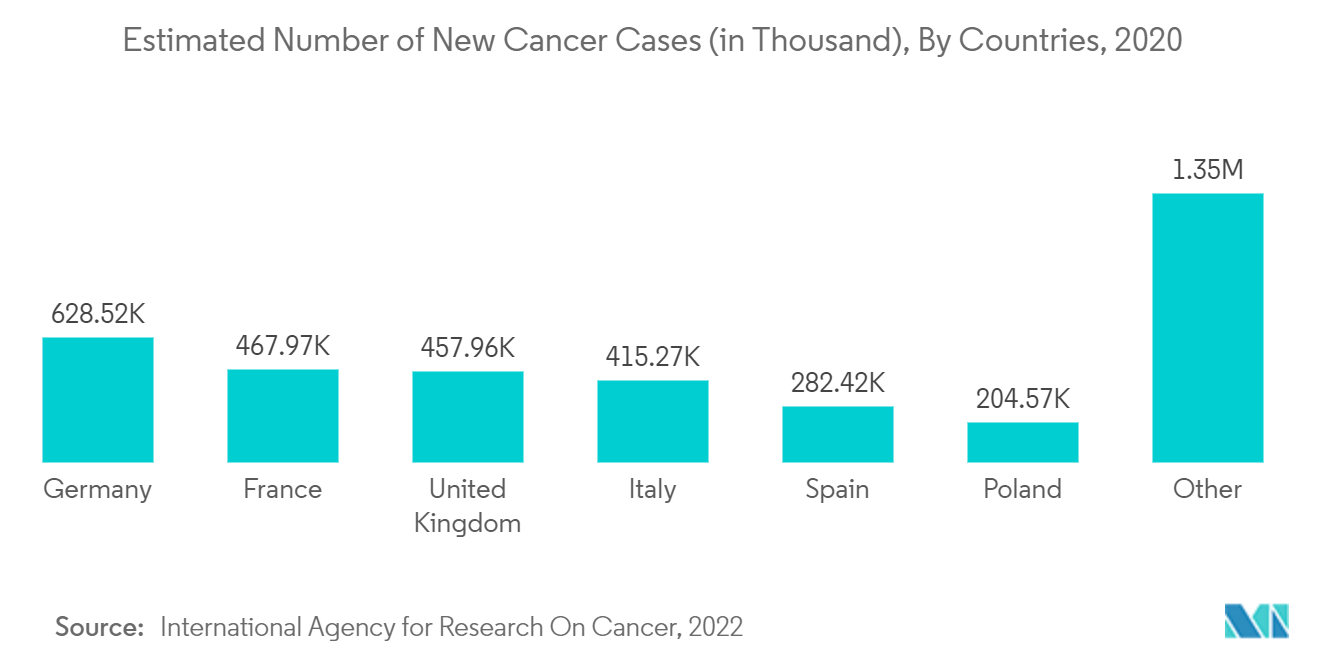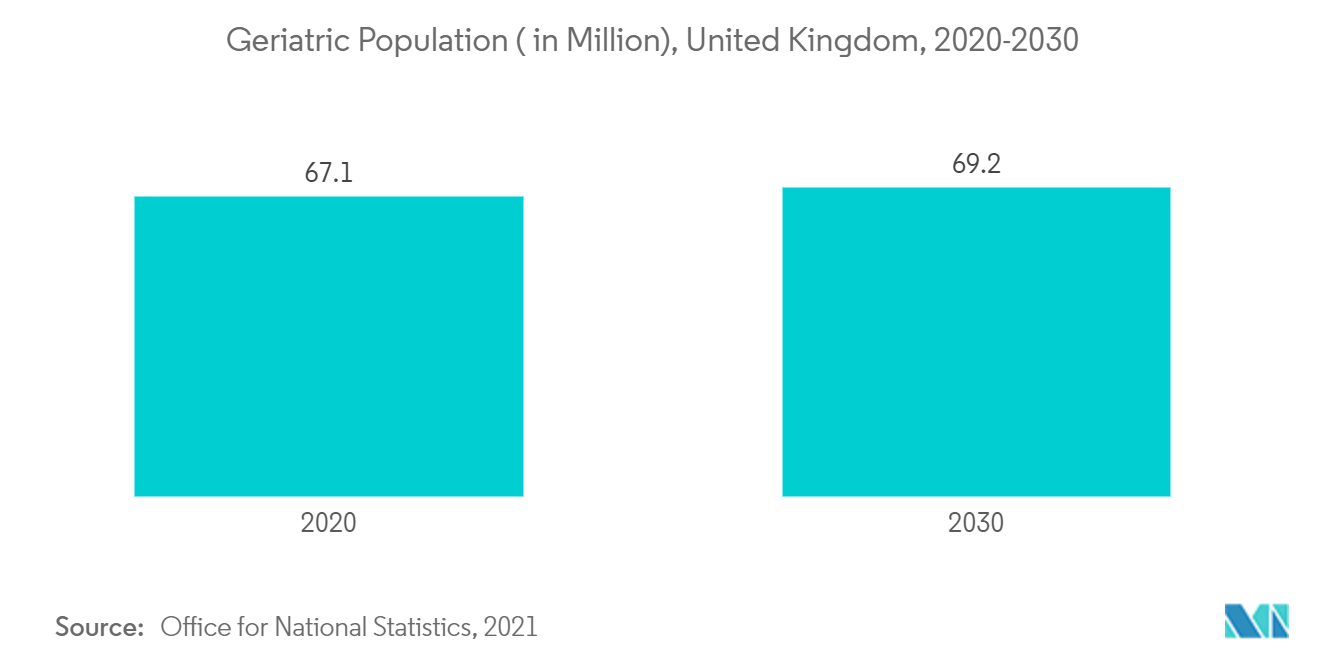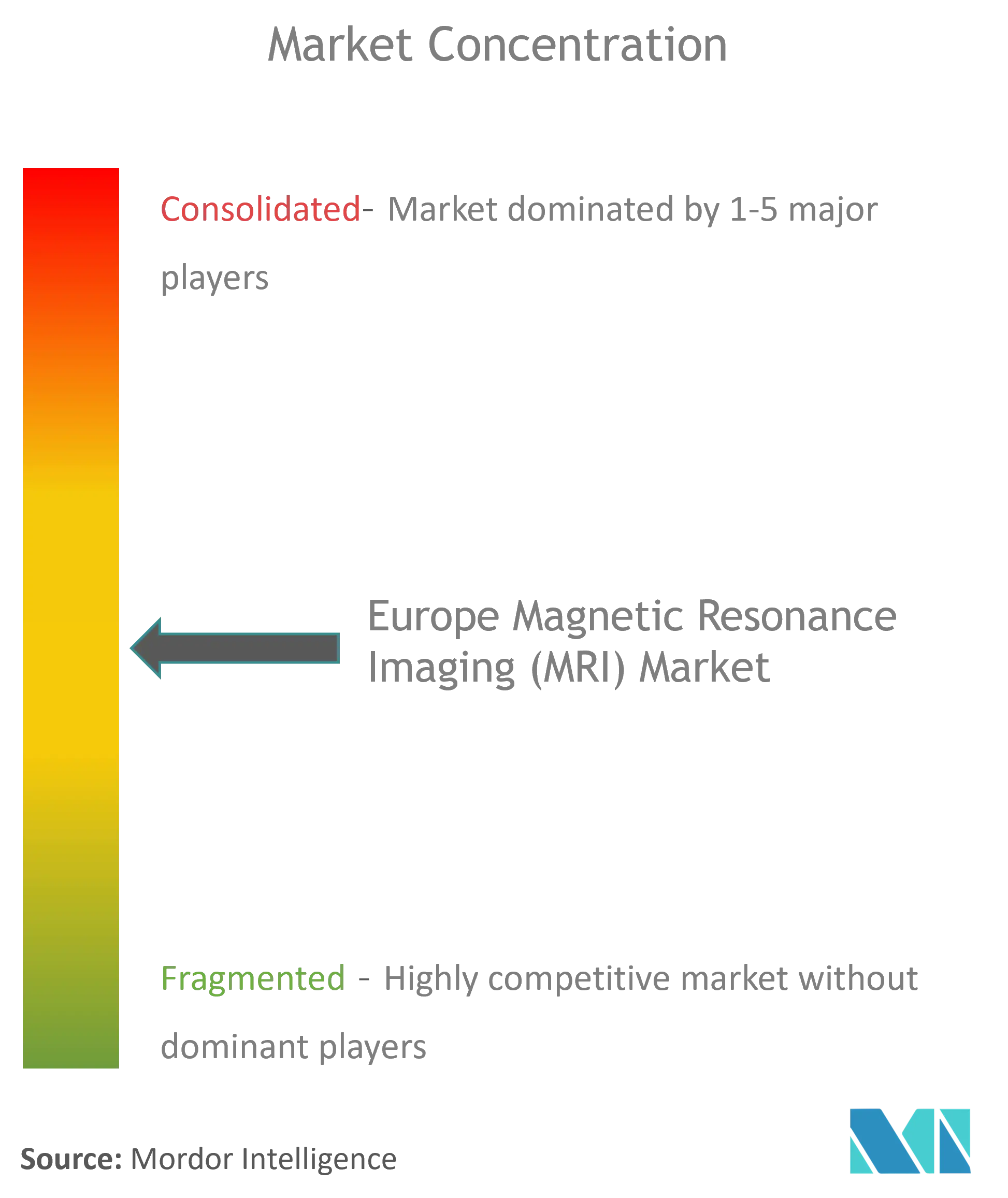Europe Magnetic Resonance Imaging (MRI) Market Size

| Study Period | 2019 - 2029 |
| Base Year For Estimation | 2023 |
| Market Size (2024) | USD 2.49 Billion |
| Market Size (2029) | USD 3.37 Billion |
| CAGR (2024 - 2029) | 6.22 % |
| Market Concentration | Low |
Major Players
*Disclaimer: Major Players sorted in no particular order |
Europe Magnetic Resonance Imaging (MRI) Market Analysis
The Europe Magnetic Resonance Imaging Market size is estimated at USD 2.49 billion in 2024, and is expected to reach USD 3.37 billion by 2029, growing at a CAGR of 6.22% during the forecast period (2024-2029).
The impact of COVID-19 on the routine diagnostics services industry has been prominent. Governments of various countries have posed restrictions on the usage of MRI, as there are high chances of contamination with the usage of large equipment. According to the study titled "Impact of COVID-19 on the imaging diagnosis of cardiac disease in Europe" published in the British Medical Journal in August 2021, comparing Northern and Southern European centers to Western and Eastern European, the likelihood of canceling all outpatient activities was higher in 2020. Compared to the rest of the globe, Europe saw a higher decrease in the number of imaging procedures. Therefore, the market expansion was constrained by a decline in imaging volume during COVID-19 in Europe.
The major factors attributing to the growth of the Europe Magnetic Resonance Imaging market are the introduction of hybrid MRI systems, availability of universal health coverage in Europe, and increasing emphasis on early diagnosis. The presence of universal healthcare coverage reduces the cost of various procedures including MRI which encourages people to take tests or treatment at regular interval which is one of the most significant growth factors for the MRI market. Universal health coverage (UHC) was endorsed in 2012 by the United Nations, which is a pillar of sustainable development and global security. Most of the European countries, provide universal health coverage and the cost of MRI scanning is reimbursed either in part or in full depending on the country. Some of the established insurance providers in Europe are National Association of Statutory Health Insurance Physicians and the Association of Private Health Insurance in Germany, Hungarian National Health Insurance Fund in Hungary, National House of Health Insurance in Romania, Health Insurance Institute of Slovenia, and KELA in Finland, among others. All these organizations provide insurance for MRI.
The usage of MRI is steadily growing, for instance, personalized care is evolving as an integral part of medicine where molecular imaging is increasing its contribution significantly through the use of non-invasive processes for accurate diagnosis and determination of diseases. As per Eurostats Statistics in February 2022, more than one fifth (20.8 %) of Europe citizens were 65 years of age or older in 2021. Between 2021 and 2100, there will be a projected 2.5-fold increase in the proportion of individuals in the Europe who are 80 years or older, from 6.0 to 14.6%. As the number of the elderly population is expected to increase in near future who are more prone to chronic conditions such as neurological diseases, and other disorders which increases diagnostic procedures and ultimately drives the market over the forecast period.
The presence of key market players, as well as other research-intensive and innovative companies in the country with huge funding for research and development activities that are involved in enhancing the MRI technology, are also expected to contribute significantly to the growth of the MRI market in Germany with the launch of advanced and cost-effective systems. For instance, in May 2021, Grosshansdorf, a Germany-based NeoscanSolution, released a small, light MRI scanner designed to keep journeys short and to scan sick babies in their sleep. This new MRI system uses digitizers and arbitrary waveform generators (AWGs) to generate scanner signals and generate results. Similarly, in October 2021, one of the most powerful MRI system of MAGNETOM 11.7T MRI system by Siemens Healthineerswas installed at NeuroSpin at CEA-Paris-Saclaybased at Frédéric Joliot Institute for Life Sciences, France.
Thus, all above mentioned factors are expected to boost the market growth. However there are few factors which may restrain the market growth such as the high cost of MRI systems.
Europe Magnetic Resonance Imaging (MRI) Market Trends
This section covers the major market trends shaping the Europe MRI Market according to our research experts:
Open MRI Systems Segment is Expected to Grow with High CAGR Over the Forecast Period in the Europe Magnetic Resonance Imaging (MRI) Market
An open magnetic resonance imaging (MRI) system, the name itself indicates it is open and can be used to take high-quality images. This system is used to accommodate claustrophobic, obese, and pediatric patients. While an open MRI does not surround the body, it is usually open on two or three sides. An Open MRI provides a more relaxed, less confining environment and lowers noise levels making it less stressful as compared to a closed system. Also, the shape of the system allows patients of all shapes and sizes to be able to make use of an MRI to accurately diagnose their problems and, it is preferred by patients having claustrophobia. Thus, the demand for open MRI systems is expected to increase over the years which will drive growth in the studied segment.
Open MRI is used to accommodate claustrophobic, obese, geriatric, and pediatric patients. Therefore, an increase in this population is anticipated to boost segment growth over the forecast period. According to the United Nations Population Fund's World Population Dashboard's Statistics 2021, people of age 65 years and above accounted for about 19.5% of the total population in Austria, 19.6% in Belgium, 20.5% in Netherlands, 19.4% in Switzerland, and 20.5% in Sweden in 2020. These large portions of aged people in European countries are expected to drive the studied market.
Cancer is also a severe burden on Europe. As per the data published by GLOBOCAN, in 2020, the prevalence of cancer was estimated at 132,014; 83,267; and 60,483 in the Netherlands, Belgium, and Switzerland, respectively. Also, approximately 49,008; 30,079; and 19,036 deaths due to cancer were recorded in the Netherlands, Belgium, and Switzerland, respectively.
The technological advancements and growing demand of advanced and comfortable diagnostic imaging systems are leading to new investments in the area and companies launching new systems in the area which is anticipated to have a positive impact on the growth of the open MRI systems segment. For instance, in March 2021, Hitachi launched two new permanent open MRI systems at the start of the 2021 European Congress of Radiology. The APERTO Lucent Plus Open MRI provides high-speed exams with motion-free images and easy siting and operation for fast return-of-image and an open design that maximizes patient comfort.

United Kingdom Holds a Significant Share in the Market and is Expected to do Same Over the Forecast Period
The presence of a sophisticated healthcare system such as the National Health Services (NHS) in the country, coupled with the growing geriatric population and increasing prevalence of chronic diseases such as cardiovascular diseases, musculoskeletal diseases, and cancer, the magnetic resonance imaging (MRI) market is expected to grow in the United Kingdom over the forecast period. For instance, according to the Globocan 2020 report, the United Kingdom reported about 457,960 new cases of cancer in 2020. Furthermore, the most prevalent forms of cancer were prostate, breast, colorectum, lung, and melanoma cancer. Also, as per the same source, the cases of cancer are expected to reach 528,902 by 2030 and 595,909 by 2040, which shows an increasing burden of cancer in the country. As MRIs are one of the major imaging devices used in tumor diagnosis and monitoring, the demand for MRI systems is expected to increase.
According to the July 2021 report of the British Heart Foundation, in the United Kingdom, roughly 7.6 million people were suffering from heart and cardiovascular disorders in 2020. Also, an aging and growing population and improved survival rates from heart and circulatory events could see these numbers rise, which is expected to significantly boost the growth of the studied market in the country.
The presence of major market players, as well as other innovative and research-intensive companies in the nation with significant financing for R&D activities involved in advancing MRI technology, are also anticipated to considerably contribute to the growth of the MRI market. For instance, in September 2021, Hyperfine Inc. announced its plans for expansion in the United Kingdom and Pakistan, and its operation in the United Kingdom will be led by Yossi Cohen, M.D., who joins the company as the United Kingdom senior medical director. Hyperfine is the United States-based company engaged in the development of innovative MRI imaging devices. Similarly, in July 2021, a new magnetic resonance imaging (MRI) scanner facility opened in Leicester, worth EUR 3.1 billion. This new facility will increase the current imaging capacity of researchers from 500 cardiovascular research participants a year to 1500. The new scanner facility has been funded by a EUR 1 million grant from the British Heart Foundation (BHF). It will be jointly owned by Leicester's Hospitals, which has dedicated EUR 2.1 million to the facility, and the University of Leicester. In March 2021, Royal Free hospital in the United Kingdom installed 3 brand new high field 3T MRI scanners to increase the department's scanning capacity and ensure that patients can be seen sooner with increased image quality and advanced scanning techniques.
Hence, growing strategic developments coupled with the upsurge in the burden of chronic diseases are all together boosting the market growth in the United Kingdom.

Europe Magnetic Resonance Imaging (MRI) Industry Overview
The Europe Magnetic Resonance Imaging market is consolidated competitive and consists of a few major players. In terms of market share, few of the major players currently dominate the market. With the increasing prevalence of diseases, technological advancements and increasing ageing population few other players are also expected to enter into the market in the coming years. Some of the major players of the market are GE Healthcare (GE Company), Hitachi Medical Systems, Koninklijke Philips NV, Siemens, and Canon Medical Systems Corporation are among others.
Europe Magnetic Resonance Imaging (MRI) Market Leaders
-
Koninklijke Philips NV
-
Siemens Healthineers
-
Canon Medical Systems Corporation
-
GE Healthcare (GE Company)
-
Fujifilm Corporation
*Disclaimer: Major Players sorted in no particular order

Europe Magnetic Resonance Imaging (MRI) Market News
- In July 2021, Philips collaborated with the Spanish National Center for Cardiovascular Research for a new ultra-fast cardiac MRI protocol to develop a magnetic resonance (MR) imaging technique that could potentially revolutionize the use of MR imaging in cardiology.
- In October 2021, Esaote launched a total body magnetic resonance imaging system called Magnifico Open, which is an open MRI system with cutting-edge technology to satisfy not only the clinical needs but also addressing operational and financial demands.
Europe Magnetic Resonance Imaging (MRI) Market Report - Table of Contents
1. INTRODUCTION
- 1.1 Study Assumptions and Market Definition
- 1.2 Scope of the Study
2. RESEARCH METHODOLOGY
3. EXECUTIVE SUMMARY
4. MARKET DYNAMICS
- 4.1 Market Overview
-
4.2 Market Drivers
- 4.2.1 Introduction of Hybrid MRI Systems
- 4.2.2 Availability of Universal health Coverage in Europe
- 4.2.3 Increasing Emphasis on Early Diagnosis
-
4.3 Market Restraints
- 4.3.1 High Cost of MRI Systems
- 4.3.2 Declining Helium Availability
-
4.4 Porter's Five Force Analysis
- 4.4.1 Threat of New Entrants
- 4.4.2 Bargaining Power of Buyers/Consumers
- 4.4.3 Bargaining Power of Suppliers
- 4.4.4 Threat of Substitute Products
- 4.4.5 Intensity of Competitive Rivalry
5. MARKET SEGMENTATION (Market Size by Value - USD Million)
-
5.1 By Architecture
- 5.1.1 Closed MRI Systems
- 5.1.2 Open MRI Systems
-
5.2 By Field Strength
- 5.2.1 Low Field MRI Systems
- 5.2.2 Medium Field MRI Systems
- 5.2.3 Very High Field MRI Systems & Ultra High MRI Systems
-
5.3 By Application
- 5.3.1 Oncology
- 5.3.2 Neurology
- 5.3.3 Cardiology
- 5.3.4 Gastroenterology
- 5.3.5 Musculoskeletal
- 5.3.6 Other Applications
-
5.4 Geography
- 5.4.1 Germany
- 5.4.2 United Kingdom
- 5.4.3 France
- 5.4.4 Italy
- 5.4.5 Spain
- 5.4.6 Rest of Europe
6. COMPETITIVE LANDSCAPE
-
6.1 Company Profiles
- 6.1.1 Bruker Corporation
- 6.1.2 Esaote SpA
- 6.1.3 Fonar Corporation
- 6.1.4 GE Healthcare (GE Company)
- 6.1.5 Fujifilm Corporation (Hitachi Medical Systems)
- 6.1.6 Neusoft Medical Systems Co., Ltd
- 6.1.7 Koninklijke Philips
- 6.1.8 Siemens Healthineers
- 6.1.9 Aurora Imaging Technology
- 6.1.10 Canon Medical Systems Corporation
- *List Not Exhaustive
7. MARKET OPPORTUNITIES AND FUTURE TRENDS
** Subject To AvailablityEurope Magnetic Resonance Imaging (MRI) Industry Segmentation
As per the scope of the report, MRI devices are electromagnetic imaging devices, which make use of radiofrequency to produce medical images. The Europe Magnetic Resonance Imaging (MRI) Market is segmented By Architecture (Closed MRI systems and Open MRI Systems), Field Strength (Low Field MRI Systems, Medium Field MRI Systems, Very High Field MRI Systems, and Ultra High MRI Systems), Application (Oncology, Neurology, Cardiology, Gastroenterology, Musculoskeletal, Other Applications) and Geography (Germany, France, United Kingdom, Italy, Spain, Rest of Europe). The report offers the value (in USD million) for the above segments.
| By Architecture | Closed MRI Systems |
| Open MRI Systems | |
| By Field Strength | Low Field MRI Systems |
| Medium Field MRI Systems | |
| Very High Field MRI Systems & Ultra High MRI Systems | |
| By Application | Oncology |
| Neurology | |
| Cardiology | |
| Gastroenterology | |
| Musculoskeletal | |
| Other Applications | |
| Geography | Germany |
| United Kingdom | |
| France | |
| Italy | |
| Spain | |
| Rest of Europe |
Europe Magnetic Resonance Imaging (MRI) Market Research FAQs
How big is the Europe Magnetic Resonance Imaging (MRI) Market?
The Europe Magnetic Resonance Imaging (MRI) Market size is expected to reach USD 2.49 billion in 2024 and grow at a CAGR of 6.22% to reach USD 3.37 billion by 2029.
What is the current Europe Magnetic Resonance Imaging (MRI) Market size?
In 2024, the Europe Magnetic Resonance Imaging (MRI) Market size is expected to reach USD 2.49 billion.
Who are the key players in Europe Magnetic Resonance Imaging (MRI) Market?
Koninklijke Philips NV, Siemens Healthineers, Canon Medical Systems Corporation, GE Healthcare (GE Company) and Fujifilm Corporation are the major companies operating in the Europe Magnetic Resonance Imaging (MRI) Market.
What years does this Europe Magnetic Resonance Imaging (MRI) Market cover, and what was the market size in 2023?
In 2023, the Europe Magnetic Resonance Imaging (MRI) Market size was estimated at USD 2.34 billion. The report covers the Europe Magnetic Resonance Imaging (MRI) Market historical market size for years: 2019, 2020, 2021, 2022 and 2023. The report also forecasts the Europe Magnetic Resonance Imaging (MRI) Market size for years: 2024, 2025, 2026, 2027, 2028 and 2029.
Europe Magnetic Resonance Imaging Industry Report
Statistics for the 2024 Europe Magnetic Resonance Imaging market share, size and revenue growth rate, created by Mordor Intelligence™ Industry Reports. Europe Magnetic Resonance Imaging analysis includes a market forecast outlook to 2029 and historical overview. Get a sample of this industry analysis as a free report PDF download.



